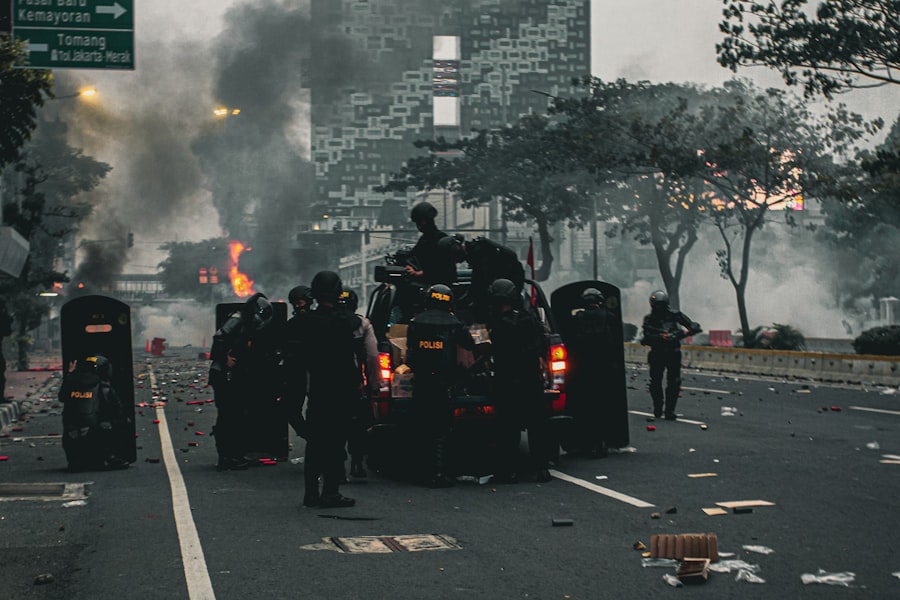Urban warfare has emerged as a critical component of modern military strategy, characterized by combat operations conducted in densely populated areas. This form of warfare presents unique challenges and complexities, as it often involves a blend of conventional military tactics and counterinsurgency operations. The urban landscape, with its high-rise buildings, narrow streets, and civilian populations, creates an environment where traditional battlefield strategies may falter.
As nations grapple with the realities of urban conflict, understanding the intricacies of urban warfare tactics becomes essential for military planners and strategists. The significance of urban warfare is underscored by the increasing frequency of conflicts occurring in cities around the globe. From the ruins of Aleppo to the streets of Mosul, urban centers have become battlegrounds where the stakes are high, and the consequences are profound.
The tactics employed in these environments must account for not only the military objectives but also the safety and well-being of civilian populations. As such, urban warfare tactics are continually evolving, shaped by historical precedents, technological advancements, and the changing nature of conflict itself.
Key Takeaways
- Urban warfare tactics have evolved significantly over time, presenting new challenges and opportunities for military forces.
- Technological advancements, such as drones and advanced surveillance systems, have revolutionized urban warfare tactics, providing new capabilities for military operations.
- Special operations forces play a crucial role in urban warfare, utilizing their unique skills and training to navigate complex urban environments.
- Civilian protection is a key consideration in urban warfare tactics, with efforts made to minimize collateral damage and protect non-combatants.
- The future of urban warfare tactics will require a balance of ethical and legal considerations, as well as innovative strategies to address the challenges of megacities and cyber warfare integration.
Evolution of Urban Warfare Tactics
The evolution of urban warfare tactics can be traced back through various historical conflicts, each contributing to the development of strategies tailored for city combat. In World War II, for instance, battles such as Stalingrad and Berlin showcased the brutal realities of urban fighting, where soldiers had to navigate through rubble-strewn streets and engage in close-quarters combat. These early encounters highlighted the need for specialized training and equipment to effectively operate in urban environments.
The lessons learned from these battles laid the groundwork for future military doctrines that would prioritize adaptability and innovation in urban settings. As conflicts progressed into the late 20th century and early 21st century, urban warfare tactics continued to evolve in response to changing geopolitical landscapes. The Gulf War and subsequent engagements in Iraq and Afghanistan demonstrated the importance of intelligence gathering, precision strikes, and the integration of various military branches.
The rise of asymmetric warfare further complicated urban combat scenarios, as non-state actors began to exploit the complexities of city environments to their advantage. This shift necessitated a reevaluation of traditional military approaches, leading to the development of new tactics that emphasized flexibility, speed, and the ability to operate within civilian populations.
Technological Advancements in Urban Warfare

Technological advancements have played a pivotal role in shaping modern urban warfare tactics. The integration of advanced weaponry, surveillance systems, and communication technologies has transformed how military forces engage in city combat. Drones, for example, have become invaluable assets for reconnaissance and targeted strikes, allowing commanders to gather real-time intelligence while minimizing risks to personnel.
These unmanned aerial vehicles can navigate through urban landscapes with precision, providing critical situational awareness that informs tactical decisions on the ground. Moreover, the proliferation of information technology has revolutionized command and control structures within urban warfare contexts. Enhanced communication systems enable seamless coordination among different units operating in complex environments.
This interconnectedness allows for rapid dissemination of information and facilitates joint operations between ground forces, air support, and intelligence units. As technology continues to advance, military planners are increasingly focused on harnessing these innovations to enhance operational effectiveness in urban settings.
Adaptation to Urban Environments
| City | Population | Green Spaces (in acres) | Air Quality Index |
|---|---|---|---|
| New York | 8,336,817 | 28,000 | 34 |
| Tokyo | 9,273,000 | 14,000 | 42 |
| London | 8,982,000 | 3,000 | 29 |
Adapting to urban environments requires a multifaceted approach that considers both the physical landscape and the social dynamics at play.
This knowledge is essential for crafting effective strategies that minimize collateral damage while achieving operational objectives.
Training programs increasingly emphasize urban combat simulations that replicate real-world scenarios, allowing soldiers to hone their skills in navigating complex terrains. Furthermore, successful adaptation involves engaging with local communities to build trust and gather intelligence. Understanding the perspectives and needs of civilians can significantly impact operational success.
Military forces are increasingly recognizing that winning hearts and minds is as crucial as achieving tactical victories. By fostering relationships with local populations, armed forces can gain valuable insights into enemy movements and intentions while simultaneously mitigating potential backlash against their presence.
Integration of Cyber Warfare in Urban Combat
The integration of cyber warfare into urban combat represents a significant shift in how conflicts are conducted in densely populated areas. As cities become increasingly reliant on digital infrastructure, adversaries can exploit vulnerabilities within these systems to disrupt communications, logistics, and even critical services such as power and water supply. Cyber operations can serve as force multipliers in urban warfare, enabling military forces to gain an advantage without engaging in direct confrontation.
Moreover, cyber warfare can be employed to influence public perception and shape narratives during conflicts. Information campaigns conducted through social media platforms can sway civilian opinions and undermine enemy morale. In urban environments where information flows rapidly, controlling the narrative becomes a vital aspect of modern warfare.
As military planners recognize the importance of cyber capabilities, they are increasingly incorporating these elements into their overall strategies for urban combat.
Role of Special Operations Forces in Urban Warfare

Special Operations Forces (SOF) play a crucial role in urban warfare due to their unique training and capabilities tailored for complex environments. These elite units are often tasked with conducting high-stakes missions that require precision and stealth within densely populated areas. Their ability to operate independently or alongside conventional forces allows them to execute targeted operations against key enemy leaders or infrastructure while minimizing collateral damage.
The versatility of SOF is particularly advantageous in urban settings where traditional military approaches may be less effective. Their training emphasizes small-unit tactics, intelligence gathering, and cultural awareness—skills that are essential for navigating the intricacies of city combat. Additionally, SOF often engage in partnerships with local forces or communities, leveraging their knowledge and resources to enhance operational effectiveness while fostering goodwill among civilians.
Civilian Protection and Urban Warfare Tactics
Protecting civilians during urban warfare is a paramount concern for military forces engaged in city combat. The presence of non-combatants complicates operational planning and execution, necessitating a delicate balance between achieving military objectives and safeguarding innocent lives. Modern urban warfare tactics increasingly prioritize minimizing civilian casualties through precision strikes and careful targeting processes.
To enhance civilian protection, militaries are adopting measures such as advanced reconnaissance techniques and intelligence-sharing initiatives with humanitarian organizations. These efforts aim to identify civilian populations at risk and develop strategies that mitigate harm during operations. Additionally, training programs now emphasize the importance of distinguishing between combatants and non-combatants, reinforcing ethical considerations within military decision-making processes.
Urban Warfare Tactics in Megacities
As global populations continue to concentrate in megacities—urban areas with populations exceeding ten million—the challenges associated with urban warfare become even more pronounced. Megacities present unique tactical dilemmas due to their vast size, intricate infrastructure, and diverse populations. Military planners must account for these factors when developing strategies for potential conflicts in such environments.
In megacities, the sheer scale of operations necessitates innovative approaches that leverage technology and intelligence capabilities. The use of drones for surveillance becomes even more critical as they can cover extensive areas quickly while providing real-time data on enemy movements. Additionally, collaboration with local law enforcement agencies can enhance situational awareness and facilitate coordinated responses to emerging threats within these sprawling urban landscapes.
Future Challenges and Opportunities in Urban Warfare Tactics
The future of urban warfare tactics is likely to be shaped by a myriad of challenges and opportunities stemming from ongoing geopolitical shifts and technological advancements. As cities continue to evolve into complex ecosystems influenced by globalization and technological integration, military forces must remain agile in adapting their strategies accordingly. The rise of hybrid threats—where conventional forces coexist with irregular combatants—will further complicate urban conflict scenarios.
Moreover, as cities become increasingly interconnected through smart technologies, vulnerabilities may arise that adversaries could exploit during conflicts. Military planners will need to anticipate these challenges while also recognizing opportunities for innovation in urban warfare tactics. Embracing new technologies such as artificial intelligence and machine learning could enhance decision-making processes and improve operational efficiency in dynamic urban environments.
Ethical and Legal Considerations in Urban Warfare
The ethical and legal considerations surrounding urban warfare are complex and multifaceted. International humanitarian law mandates that parties engaged in armed conflict take all feasible precautions to protect civilians from harm. This obligation becomes particularly challenging in urban settings where distinguishing between combatants and non-combatants can be difficult due to the close proximity of civilian populations.
Military forces must navigate these legal frameworks while also addressing moral imperatives related to civilian protection. The potential for collateral damage raises profound ethical questions about the justification for military actions within populated areas.
The Future of Urban Warfare Tactics
In conclusion, the future of urban warfare tactics will undoubtedly be shaped by an interplay of historical lessons learned, technological advancements, and evolving geopolitical dynamics. As cities continue to serve as battlegrounds for modern conflicts, military forces must remain adaptable and innovative in their approaches to urban combat. The integration of cyber capabilities, special operations forces, and a focus on civilian protection will be critical components of successful strategies moving forward.
Ultimately, understanding the complexities inherent in urban warfare will be essential for military planners as they navigate an increasingly interconnected world marked by rapid change. By prioritizing ethical considerations alongside operational effectiveness, armed forces can strive to achieve their objectives while minimizing harm to civilian populations—a goal that remains paramount in any discussion surrounding the future of urban warfare tactics.
In exploring the future of urban warfare tactics, it’s essential to consider the evolving landscape of military strategy and technology. A related article that delves into these themes can be found on the website “In the War Room.” This article provides insights into how urban environments are reshaping military operations and the innovative tactics being developed to address these challenges. For a deeper understanding of these dynamics, you can read more about it by visiting




